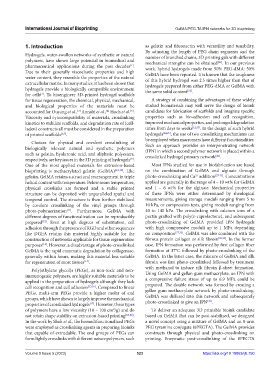Page 531 - IJB-9-5
P. 531
International Journal of Bioprinting GelMA/PEG-TA IPN networks for 3D bioprinting
1. Introduction as gelatin and fibronectin with versatility and tunability.
By adjusting the length of PEG chain segments and the
Hydrogels, water-swollen networks of synthetic or natural number of branched chains, 3D printing gels with different
polymers, have shown large potential in biomedical and mechanical strengths can be obtained . In our previous
[21]
pharmaceutical applications during the past decades . work, hybrid hydrogels made from 50% PEG-dMA: 50%
[1]
Due to their generally viscoelastic properties and high GelMA have been reported. It is known that the toughness
water content, they resemble the properties of the natural of this hybrid hydrogel was 2.5 times higher than that of
extracellular matrix. In many studies, it has been shown that hydrogels prepared from either PEG-dMA or GelMA with
hydrogels provide a biologically compatible environment the same solid content .
[22]
for cells . To bioengineer 3D-printed hydrogel scaffolds
[2]
for tissue regeneration, the chemical, physical, mechanical, A strategy of combining the advantages of these widely
and biological properties of the materials must be studied biomaterials may well serve the design of bioink
accounted for Ouyang et al., Annabi et al., Hoch et al. . candidates for fabrication of scaffolds and integrate specific
[3]
[5]
[4]
Viscosity and cytocompatibility of materials, crosslinking properties such as bio-adhesion and cell recognition,
kinetics to stabilize scaffolds, and degradation rate of (cell- improved mechanical properties, and prolonged degradation
laden) constructs all must be considered in the preparation times from days to weeks [12,23] . In the design of such hybrid
of printed scaffolds [6,7] . hydrogels [24,25] , the use of two crosslinking mechanisms can
be employed when macromers have different functionalities.
Choices for physical and covalent crosslinking of
biologically relevant natural and synthetic polymers Such an approach provides an interpenetrating network
(IPN) in which a second polymer network is placed within a
such as gelatin, hyaluronic acid, and aliphatic polyesters, crosslinked hydrogel primary network .
[26]
[8]
respectively, are key issues in the 3D printing of hydrogels .
One of the most applied materials for extrusion-based Most IPNs studied for use in biofabrication are based
bioprinting is methacrylated gelatin (GelMA) [6,9,10] . Like on the combination of GelMA and alginate through
gelatin, GelMA retains a structural rearrangement in triple photo-crosslinking and Ca addition [27-31] . Concentrations
2+
helical content with temperature. Below room temperature, applied are generally in the range of 4 – 10 wt% for GelMA
physical crosslinks are formed and a stable printed and 1 – 6 wt% for the alginate. Mechanical properties
structure can be deposited with unparalleled spatial and of these IPNs were either determined by rheological
temporal control. The structure is then further stabilized measurements, giving storage moduli ranging from 5 to
by covalent crosslinking of the vinyl groups through 10 kPa, or compression tests, giving moduli ranging from
[11]
photo-polymerization . Furthermore, GelMA with 40 to 140 kPa. The crosslinking with calcium ions of a
different degrees of functionalization can be reproducibly pectin grafted with poly(ε-caprolactone), and subsequent
prepared . Even at high degrees of substitution, cell photo-crosslinking of GelMA provided IPN hydrogels
[12]
adhesion through the presence of RGD and other sequences with high compressive moduli up to 1 MPa depending
like DGEA retains this material highly suitable for the on composition [27,32] . GelMA was also combined with the
construction of networks applicable for tissue regeneration fibrous protein collagen or silk fibroin [33,34] . In the former
purposes . However, a disadvantage of photo-crosslinked case, IPN formation was performed by first collagen fiber
[13]
GelMA is the rapid enzymatic degradation by collagenase, formation at 37°C followed by photo-crosslinking of the
generally within hours, making this material less suitable GelMA. In the latter case, the mixture of GelMA and silk
[14]
for regeneration of most tissues . fibroin was first photo-crosslinked followed by treatment
with methanol to induce silk fibroin β-sheet formation.
Poly(ethylene glycol)s (PEGs), as non-toxic and non-
immunogenic polymers, are highly suitable materials to be Using GelMA and gellan gum methacrylate, an IPN with
a compressive failure stress of up to 6.9 MPa could be
applied in the preparation of hydrogels although they lack
cell recognition and cell adhesion [15,16] . Compared to linear prepared. The double network was formed by creating a
PEGs, multi-arm PEGs provide a higher molar of end gellan gum methacrylate network by photo-crosslinking.
groups, which have shown to largely improve the mechanical GelMA was diffused into this network and subsequently
[35]
properties of crosslinked hydrogels . However, these types photo-crosslinked to give an IPN .
[17]
of polymers have a low viscosity (10 – 100 cm /g) and do To deliver an adequate 3D printable bioink candidate
3
not retain shape stability on extrusion-based printing [18-20] . based on GelMA that can be post-stabilized, we designed
In the work by Shah et al., the homodifunctionalized PEGs a novel concept using a mixture of GelMA and an 8-arm
were employed as crosslinking agents in preparing bioinks PEG tyramine conjugate (8PEGTA). The GelMA provides
that capable of extrudable. The end groups of PEGs can constructs through physical and photo-crosslinking on
form lightly crosslinks with different nature polymers, such printing. Enzymatic post-crosslinking of the 8PEGTA
Volume 9 Issue 5 (2023) 523 https://doi.org/10.18063/ijb.750

